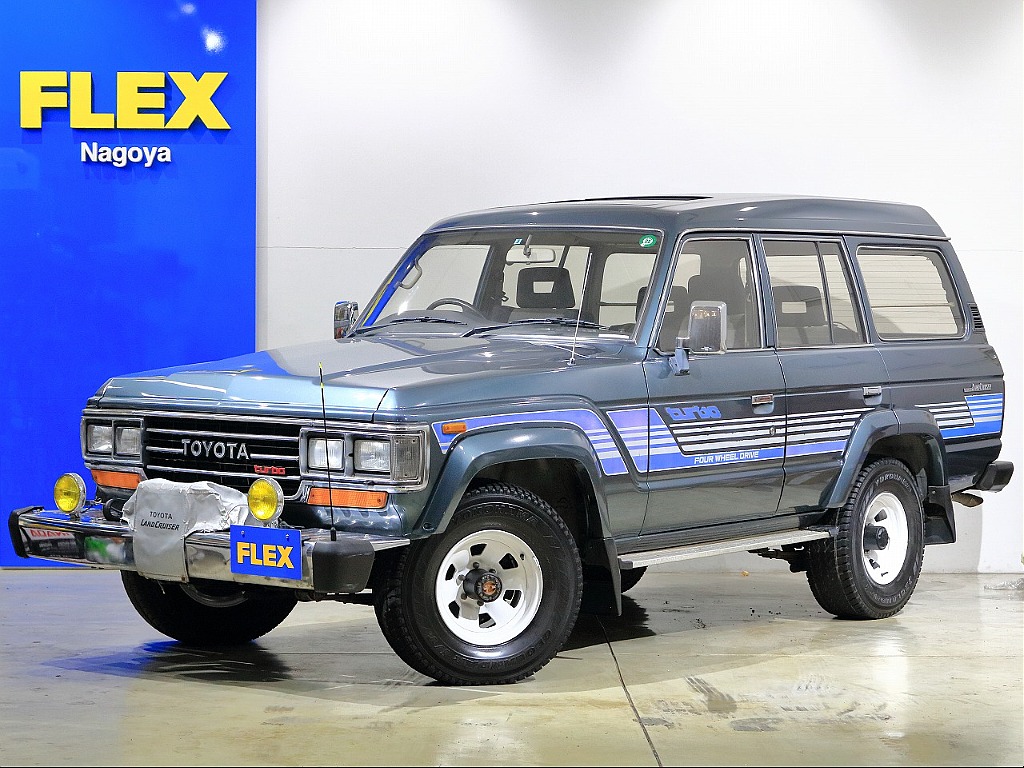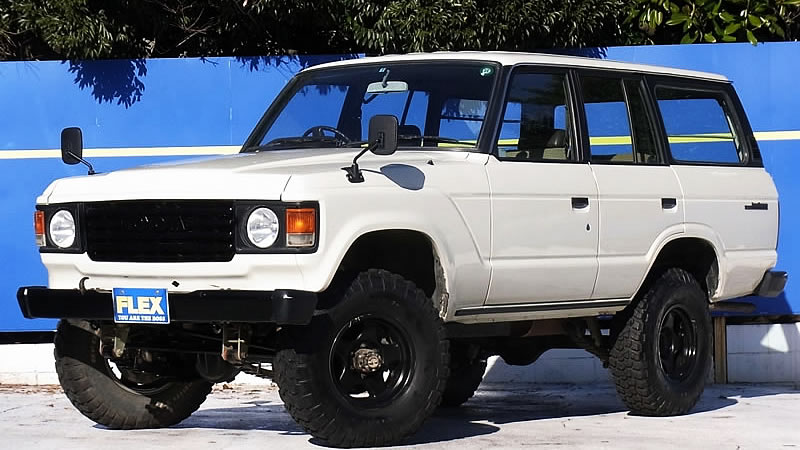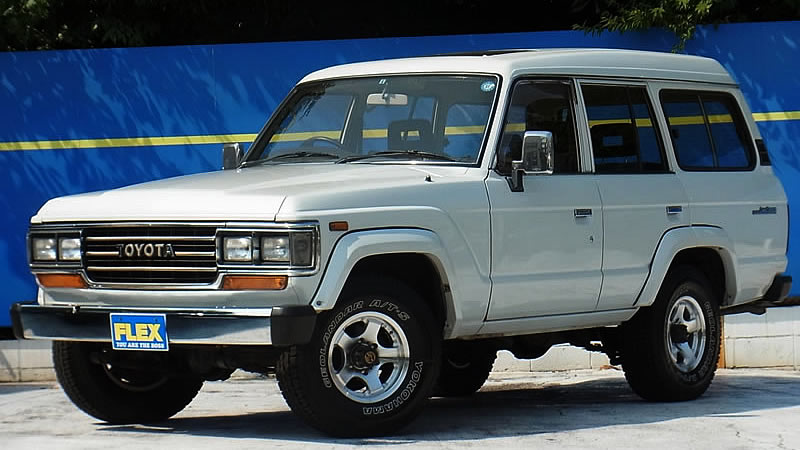What is the Land Cruiser 60?
A larger body station wagon for the North American buyer
A station wagon is a passenger vehicle that can carry a lot of people very comfortably, as well as have room for their luggage. When the Land Cruiser 60 debuted as a successor to the Land Cruiser 55 in 1980, it was classified as a station wagon. It is closer to today’s SUVs than older model station wagons. It was equipped with the latest comfort and convenience features of the time.
The Land Cruiser 55 derived from the Land Cruiser 40 in 1967, and it was the size of a small Japanese car and equipped like a small truck. Toyota quickly realized that they needed to change their sales strategy if they were going to compete in the North American market, so they designed the Land Cruiser 60.
The Land Cruiser 55 had a total length of 15.34 feet/184.05 inches and a total width of 5.58 feet/66.93 inches. Toyota used this frame for the Land Cruiser 60, but they extended the wheelbase by 1.18 inches and increased the width to 5.9 feet / 70.86 inches. The overall length of the new Land Cruiser 60 was now 15.59 feet / 187.10 inches.
Toyota used resin on the interior to reduce the exposed iron plate. They upgraded the interior seating to cloth over the previous vinyl for a more passenger car look and feel.
Most of the current Japanese market for the Land Cruiser 60 consisted of government agencies and business operators, but these improvements were added to new cars. The Land Cruiser 80 in 1989 helped improve the Japanese leisure car market.
Land Cruiser 60 exterior and interior comparison with past models
| Model | Landcruiser 60 | Landcruiser 80 | Landcruiser 70 |
|---|---|---|---|
| Sale Period | August 1980 to December 1989 | December 1989-December 1997 | August 2014 to June 2015 |
| Full Length | 15.58 ft / 190.94 in | 16.34 ft / 196.07 in | 15.62 ft / 187.40 in |
| Full Width | 6.17 ft /74.02 in | 6.33 ft / 75.98 in | 6.18 ft / 74.21 in |
| Full Height | 6.38 ft / 76.57 in | 6.10 ft / 73.23 in | 6.20 ft / 72.24 in |
| Minimum turning radius | 244 inches | 236 inches | 248 inches |
| Vehicle weight | 4,210 ~ 4,894 lbs | 4,828 ~ 5,093 lbs | 4,497 ~ 5,071 lbs |
| Boarding capacity | 5/8people | 5/8people | 5people |
| Engine Type | Gasoline: 4.2L (straight 6: 2F) → 4.0L (straight 6: 3F) Diesel: 3.4L (straight 4: 3B) / 4.0L (straight 6: 2H) / 4.0L (straight 6 turbo: 12H-T) | Gasoline: 4.0L (straight 6: 3F-E) → 4.5L (straight 6: 1FZ-FE) Diesel: 4.2L (straight 6: 1HZ) / 4.2L (straight 6 turbo: 1HD-T) | Gasoline: 4.0L (V6: 1GR-FE) Diesel: No setting |
| 4WD system | Part-time | Full-time | Part-time |
| MSRP | $12,515 ~ $23,390 | $18,739 ~ $26,673 |
*Body size is a typical final model (excluding optional equipment, etc.)
*70 is a 30th anniversary limited gasoline model
*Vehicle weight does not include optional equipment
*The price when new is the manufacturer’s suggested retail price of the final model.
The widebody is created by widening the ladder frame
The Land Cruiser 60 uses the same 4-door large 2-box body style as the Land Cruiser 55. By significantly rearranging the ladder frame, Toyota was able to create a widebody. They widened the gap between the left and right side rails from front to back and changed the placement and number of cross members to improve the frame size and rigidity. This enabled Toyota to make the body width 70-inches, which improved the load capacity.
The same front and rear suspension from the Land Cruiser 55 with leaf springs were used in the Land Cruiser 60. Heavy-type tires were adopted to improve load resistance. The standard base trim tire has a maximum load capacity of 1,100 pounds, which is mainly for business and is a 7.00-15-8PR. This is a 15-inch truck tire with a ply rating of ‘8’. It prioritizes load over comfort.
In the upper trim levels, the springs have a softer setting. This reduces the load capacity to 771 pounds and uses a lower PR tire.
The Land Cruiser 60 is offered in a range of lineups to appeal to a wider audience other than those switching from the Land Cruiser 40. Drivers looking for a larger passenger car turned to the Land Cruiser 60, which increased their global station wagon market share.
Land Cruiser’s first trim level development, advanced trim levels with full specifications
The Land Cruiser 60 is the first Land Cruiser model with a trim level. Until then, there were no trim levels for the Land Cruiser 40 or the Land Cruiser 55.
The Land Cruiser 60 was available in three trim levels: STD, GX and VX. Because of the introduction of trim options, Toyota was able to give buyers choices like engine types, roof heights, transmissions and other options.
The engine was initially a 3.4L inline 4 diesel 3B, the same as the Land Cruiser 40, and a 4.2L inline 6 gasoline engine inherited from the Land Cruiser 55. It also evolved and switched to a new model year by year, and the diesel engine eventually became two models: a 4.0L straight 6 2H and a 4.0L straight 6 diesel turbo 12H-T that shared the basic design.
In addition, the gasoline engine has evolved into a 4.0L inline 6 3F-E with electronically controlled fuel injection after major improvements around the cylinder head.
The first Land Cruiser 60 equipped with the 3F-E gasoline engine is the 8-seat 3-number VX wagon. Normally, diesel engine vehicles have strict exhaust gas regulations and are 5-seat 1-number vans even at higher trim packages.
In addition, the part-time 4WD system is the same as the Land Cruiser 55. Originally, shifting between 2WD and 4WD was done via a shift lever on the side of the transmission, but later Toyota made it an electronic shift between modes by way of a button on the instrument panel.
Changes in Land Cruiser 60 specifications and equipment
August 1980
The Land Cruiser 60 became a successor of the Land Cruiser 55. As a station wagon, it was the second generation and had a larger body. It was equipped with a 3.4L straight 4 diesel engine that was used in the Land Cruiser 40 or a 4.2L straight 6 gasoline from the Land Cruiser 55.
October 1982
Toyota made minor changes at the same time as the Land Cruiser 40. A 4.0L straight 6 diesel engine has been added to the engine lineup, and the other 3.4L straight 4 diesel and 4.2L straight 6 gasoline meet the new emission regulations. In addition to the 4-speed manual transmission, the diesel specification car has a 5-speed manual transmission, and a high roof specification has been added to the roof shape.
November 1984
In response to a minor change, the gasoline engine was changed from a 4.2L inline 6 to a newly developed 4.0L inline 6 type.
October 1985
A direct-injection turbo diesel engine was added to the previous 4.0L in-line 6 engine. A 4-speed automatic transmission was offered for the first time in a model equipped with two types of 4.0L in-line 6 diesel engines.
August 1986
The 3.4L in-line 4 diesel engine that was used in the base trim level of the Land Cruiser 60 was discontinued.
August 1987
The headlamps were changed from two round headlights to four square headlights, and the front grille mask was redesigned. The instrument panel was completely changed from a combination type of iron plate and resin to a modern design like a passenger car dash.
August 1988
The 4.0L in-line 6 gasoline engine, complete with electronically controlled specifications, has been added to the high-grade trim level. The VX wagon equipped with this engine was the Land Cruiser 60’s first 8-seat 3-number vehicle.
Land Cruiser 60 engine type
The initial gasoline engine installed in the Land Cruiser 60 was the same 4.2L straight 6 2F (140PS, 30.0kgm) installed in the Land Cruiser 55, and although it was a gasoline specification, it was a low-speed rotation with an emphasis on torque.
In addition, the diesel engine is a 3.4L 3B (98PS, 23.0kgm), which is a scaled-up version of the 3.2L in-line 4 diesel engine 2B that was installed in the Land Cruiser 40 at that time. It is an engine type that has increased practicality with a relatively small displacement. This two-model system was later expanded to include a lineup of diesel engine specifications for the domestic market, where maintenance costs such as taxation and fuel efficiency are relatively reasonable.
The 3.4L inline 4 diesel 3B remained until the middle of the model for the base level, but the 4.0L inline 6 diesel 2H (105PS, 25.5kgm) and diesel turbo 12H-T (135PS, 32.0kgm) that appeared to be overlapping became the main engine choices.
As the gasoline engine evolved from 2F to 3F (145PS, 28.0kgm) and then to 3F-E (155PS, 29.5kgm), vehicles equipped with it became more sophisticated. The model was equipped with a 4.0L in-line 6 3F-E, which evolved from the carburetor type up to that time and became an electronically controlled fuel injection, cleared gasoline emission regulations and finally became a 3-number car with a 3rd-row seat.
Land Cruiser 60 Test Drive Impression & Report
Difference in engine performance is the difference in driving performance
Thanks to the increased tread (distance between the center of the width of the left and right tires) along with the larger body, the Land Cruiser 60 has the same leaf spring specifications as the Land Cruiser 55, but its steering stability has been greatly improved.
The change in posture, which is affected by the number of passengers and load capacity, is also suppressed, realizing total and safe driving from on-road to off-road. Ride quality is divided into whether it is for cargo or passenger depending on the installed engine and grade.
For a 5-seater van model, the 771-pound specification, which is common in the upper grades, is softer and more comfortable than the 1,102-pound specification. However, the characteristic of the Land Cruiser 60 is that it is the engine rather than the suspension that determines the driving performance.
For diesel vehicles, 4.0L straight 6 2H and turbocharged 12H-T are better than 3.4L straight 4 3B. The difference in torque and acceleration performance will be the same as the difference in how they run.
It is subtle in a gasoline car, and the early model 4.2L straight 6 2F has torque like a diesel engine. The 4.0L straight-six 3F and 3F-E, which have been subject to stricter emission regulations, have changed their design to gain power through rotation rather than torque, so it can be said that they are easier to handle than the 2F.
It’s not that you can’t enjoy low-speed off-road driving with the 3F and 3F-E, which are a little weak in torque, but the old-fashioned and inefficient 2F is as reliable as the 2H diesel engine.
Land Cruiser 60 Tips for choosing a used car
Aiming for a custom refreshed 60
The Land Cruiser 60 has been 36 years since its debut as a new car and 27 years since it was discontinued, but there are plenty of used cars on the market today.
Diesel engine vehicles, like other Land Cruisers, cannot be registered in regulated areas, but it is not difficult to find a specification you like by engine type and trim. It seems that there are many models that old fans have inherited, and many of the vehicles are in good condition for their model year.
One thing to watch out for is custom off-road vehicles that have been abused on bad roads. Even if the condition is good, the mechanics are old, and there is a high possibility that the gearbox and axle area are damaged, so I would choose one that has been properly maintained.
As expected, the interior cannot be expected to be in the same condition as a new car in its original state. Seats are often replaced with custom seats, so when purchasing, it is a good idea to check how they fit your body and how the shift lever works while sitting.
In addition, there are many cases where the body of the Land Cruiser 60 has been completely repainted, and the tires and wheels have been arranged to be stylish and large in diameter.
Leave aside from materialism and enjoy the unique Land Cruiser 60 world
The charm of the Land Cruiser 60 seems to be expanding year after year. Many new owners like to customize their LC60 in a retro style or leave the original equipment intact. The Land Cruiser 60 frees you to enjoy the vehicle more than whether or not it is new or old, whether it has convenient and high-end equipment, or whether it has power or not. Many genuine parts have already been discontinued, but aftermarket replacement parts are available, and there are many fan-based communities where people share information and advice about the Land Cruiser 60. You will find that the LC60 doesn’t need much to give you years of use.
You will find that the Land Cruiser 60 offers the pure 4WD station wagon experience. The Land Cruiser 80 and Land Cruiser 100 later evolved into luxury SUVs, thanks in part to electronic control technology and other high-tech upgrades.
The Land Cruiser 60 attracts an increasing number of young people who are drawn to simplicity and decide to embrace it.




